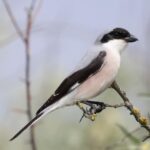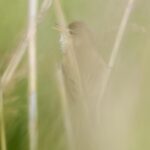Day 3 of a three day Winter & Brecks Tour, aiming to catch up with some of our wintering birds in North Norfolk, as well as the specialities of early spring in the Brecks, our final day. The weather forecast was not great again, with a band of heavy rain expected to move in quickly this morning and last for several hours, but as we have seen repeatedly over the last couple of days, it would be very foolish to rely on the forecast!
Having missed the Pallid Harrier over the last couple of days, the news that it was back early this morning was too tempting to miss. A quick visit by this correspondent on the way to collect the group confirmed where it was and soon we were all back watching this great bird.
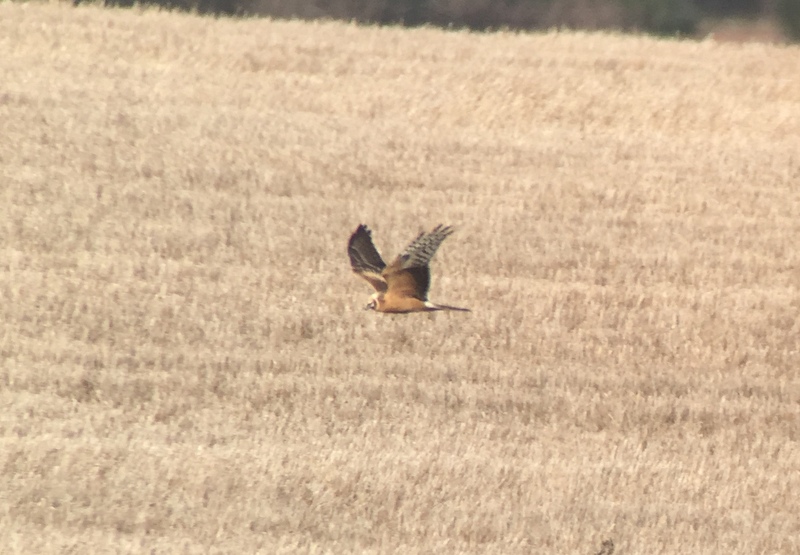 Pallid Harrier – we finally caught up with the juvenile at New Holkham
Pallid Harrier – we finally caught up with the juvenile at New Holkham
It was nice and sunny first thing this morning in North Norfolk and excellent light. The Pallid Harrier was hunting over a more distant wheat field at first, flying low over the ground or down the hedge lines looking for food, trying to flush small birds or find small mammals. It was very narrow winged compared to the other harriers we had seen over the weekend, with a pointed ‘hand’, and an agile flight action.
Gradually the Pallid Harrier worked its way back towards us, at times disappearing behind a ridge. When it worked its way back along a hedge at one point, a Merlin appeared with it. The Merlin perched up on the hedge while the Pallid Harrier flew over the verge beside. The Merlin was probably looking for small birds flushed by the harrier, which it could chase after itself.
Finally the Pallid Harrier came in over a stubble field, just across from us. As it banked and turned, the morning sun caught on its underparts, which glowed orange, typical of a juvenile. Its upperparts were contrastingly dark brown, with a white square at the base of the tail and a pale creamy patch across the coverts. Through the scope, it was possible to see the Pallid Harrier‘s diagnostic pale collar and dark ‘boa’, the brown patches on the side of the neck behind the collar.
It flew back and forth over the stubble field for a while, allowing us all to get a great look at it, then the Pallid Harrier flew across to one side, had a quick stoop at an unsuspecting female Pheasant, and disappeared across the road. Wow!
It had been well worth the stop. Although we were intending to head back down to the Brecks this morning, this was just about on our way. As we finally got underway again and headed south, it started to rain. It was a bit earlier than expected, so it was good that we had been able to make the most of the early sunshine.
Our first stop in the Brecks was at Santon Downham. When we got out of the cars, yes it was raining, but it wasn’t exactly raining hard. The conditions were a long way from ideal, but we decided to give it a go and have a walk along the river. Our real target here was going to be Lesser Spotted Woodpecker, but that was going to be a real challenge to find now. As we walked along, a couple of Green Woodpeckers laughed at us from the trees. It didn’t sound like they thought much of our prospects! A sharp ‘kik’ call alerted us to the presence of a Great Spotted Woodpecker and we looked up to see it flying through the tops and landing high in a bare tree.
There were other birds along here too. A Crossbill flew over calling and landed in the top of a tall poplar. Through binoculars we could see that it was a red male and it then started singing, a jumbled mixture of call notes and quiet wheezes and trills, not much to write home about as birdsong goes but interesting to hear. A couple of Marsh Tits called from further back in the undergrowth. A Nuthatch was piping from somewhere in the trees too.
When we got to the Lesser Spotted Woodpeckers‘ favourite trees, all was quiet. We stood listening for a few minutes, and while we were standing there we turned to look across at the alders the other side. There was a lot of activity in the trees. A pair of Treecreepers were chasing each other round and round between the trunks. A couple of Siskins were swinging in the branches. There were several tits there too and a Nuthatch.
One of the group caught sight of a woodpecker and as we turned to look, a Great Spotted Woodpecker flicked across onto a tree. Then a much smaller bird appeared on the trunk of the tree behind. Rather than the bold white shoulder patches of the Great Spotted Woodpecker, it was densely barred with white on its black back and wings. It was a Lesser Spotted Woodpecker!
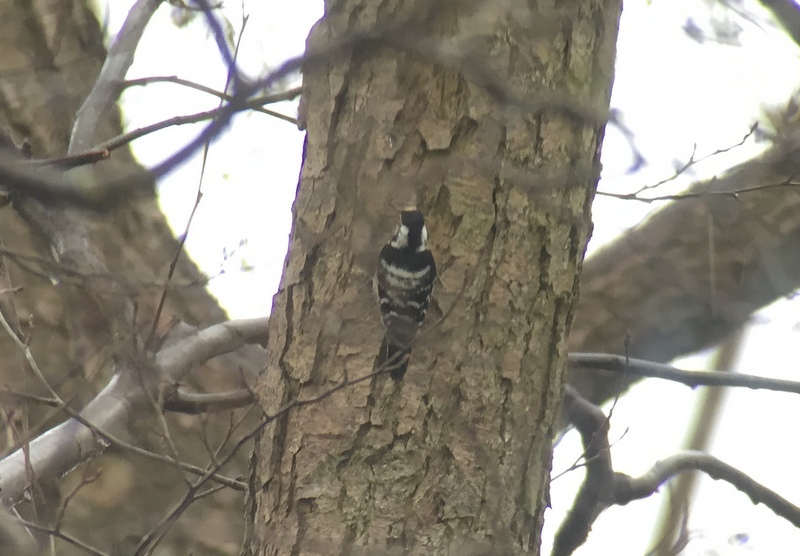 Lesser Spotted Woodpecker – barred with white on its back and wings
Lesser Spotted Woodpecker – barred with white on its back and wings
It was a female Lesser Spotted Woodpecker, lacking the red crown of the male. It was hard to get onto at first, as it kept flitting between trees, climbing up the trunks and sometimes disappearing round the back or behind other trees. With a bit of perseverance, we managed to get it in the scope and everyone had a great look at it. What an unexpected result!
When it disappeared deeper into the trees, we decided not to push our luck and headed back the way we had come. We stopped to look at a large flock of Siskins in the alders and found at least one Lesser Redpoll in with them. There were a few Bramblings in the trees too and a large flock of Redwings flew up from the meadows as we passed.
It stopped raining as we walked back, which was a most welcome surprise! It seemed like the band of rain had passed over much more quickly than expected and without raining as hard. It was still grey and damp though. We had a quick look up around the churchyard to see if we could find any Firecrests, but that was pushing our luck too far.
Before lunch, we had a quick drive over to Thetford, to the delights of a recycling centre on an industrial estate – there is nothing if not a variety in our choice of venues! This has been a very good spot for gulls in recent weeks. A Sunday is never the best day to look for them here, as the recycling centre is closed, although they often loaf around on the roofs anyway. Perhaps because of the earlier rain, there were very few today, just a few Lesser Black-backed and Herring Gulls, so we didn’t stop long.
Lakenheath Fen was our destination for the afternoon. We ate our lunch in the visitor centre, looking out at the feeders. A steady stream of birds came in and out – mainly Reed Buntings, Goldfinches and tits. One of the volunteers kindly drew our attention to a Water Rail which was lurking in the cut reeds below the balcony, before it scuttled back into cover.
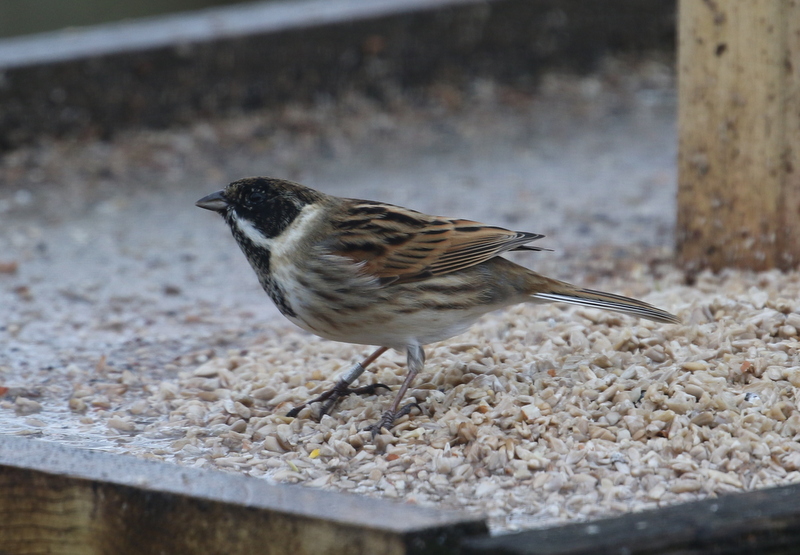 Reed Bunting – a variety came in to feed by the visitor centre
Reed Bunting – a variety came in to feed by the visitor centre
It had started to brighten up from the west over lunch, so we set off to explore the reserve. It was still cool and damp as we walked down the path to New Fen. A Marsh Harrier was quartering over the reeds – it was a young bird and was carrying green wings tags on its wings. Unfortunately, despite our best efforts with scopes, we were unable to read the code, however it had most likely been ringed here.
There were several ducks on the water in front of the viewpoint, mainly Gadwall plus a few Mallard and Teal. Gadwall are one of the most under-rated of ducks, the male’s apparently grey plumage actually being a variety of different patterns – barring, scalloping, streaking – so we had a good look at one through the scope. A Common Snipe flew up and landed back down on the edge of the reeds briefly before scuttling back into cover. A Cetti’s Warbler sang half-heartedly from deep in the reeds.
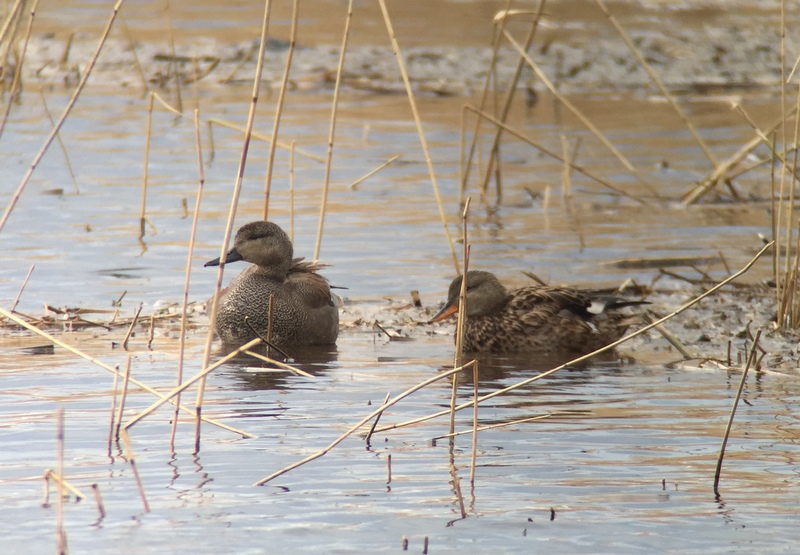 Gadwall – the most under-rated of ducks
Gadwall – the most under-rated of ducks
We pressed on west. There was no sign of any Common Cranes from Joist Fen viewpoint. A Cormorant was on a post, drying its wings. Several Marsh Harriers were quartering over the reeds. A Common Buzzard was standing on a fence post at the edge of the paddocks. There were still some dark clouds coming in on the brisk wind, so we waited while they passed over, even though it did nothing more than spit with rain for a few seconds. Once they were gone, we headed up to the river bank.
Scanning the fields north of the river, we spotted a pair of Common Cranes some way over. We got them in the scope, and we could see they were two adults, with well-marked black and white heads and a red patch on the top. We presumed they were one of the two regular breeding pairs from the reserve.
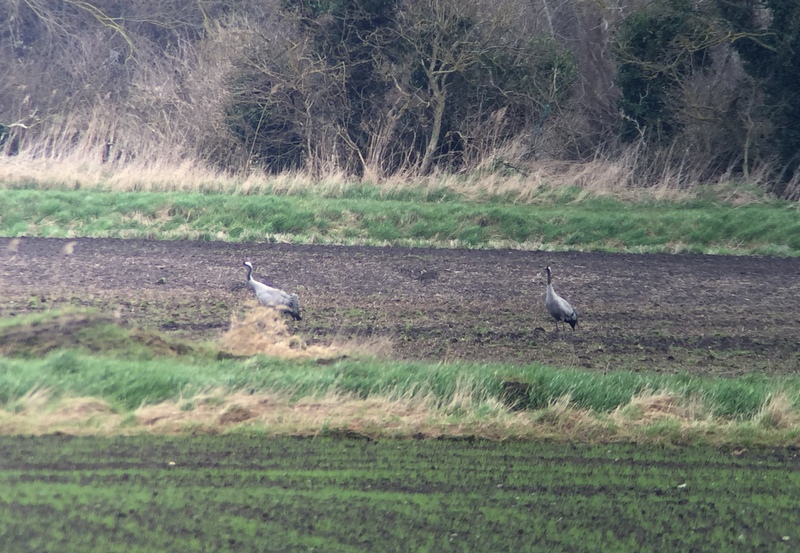 Common Crane – one of the breeding pairs, in a field north of the river
Common Crane – one of the breeding pairs, in a field north of the river
While we were watching this pair, we could hear more Cranes bugling further over, which prompted the ones we were observing to respond. Then a second pair of Cranes flew in and landed right next to the first. This second pair started to display, duetting with their heads pointing skywards.This was all slightly perplexing, as it would be odd for the other resident pair to trespass in the other’s territory.
The original pair then took off and it looked like they would land again a couple of fields over, but instead they flushed a fifth Crane which took off too. Now we knew already from one of the wardens that one of the resident Crane pairs had just today been trying to kick their juvenile born last year out of their territory. In the last few days it had still been accompanying the two adults everywhere, but it had been seen on its own earlier. It quickly became clear that this was the juvenile we were seeing take off, chased by its parents.
These three Cranes flew off over the reserve and disappeared over the trees way to the south, and they were soon followed by the other pair. However, after a few seconds they came back and the three landed down in the edge of the reedbed. Through the scope, we could see it was the pair and the juvenile. Then the other pair flew over and they took off again.
All five Cranes flew up and landed on the river bank. At this stage, we were still assuming that we were watching the two resident pairs with the one remaining juvenile from 2016. However, while they were standing on the bank, another pair of Cranes walked up to join them, duetting as they did so. We could now see seven Cranes standing on the bank together, in a line!
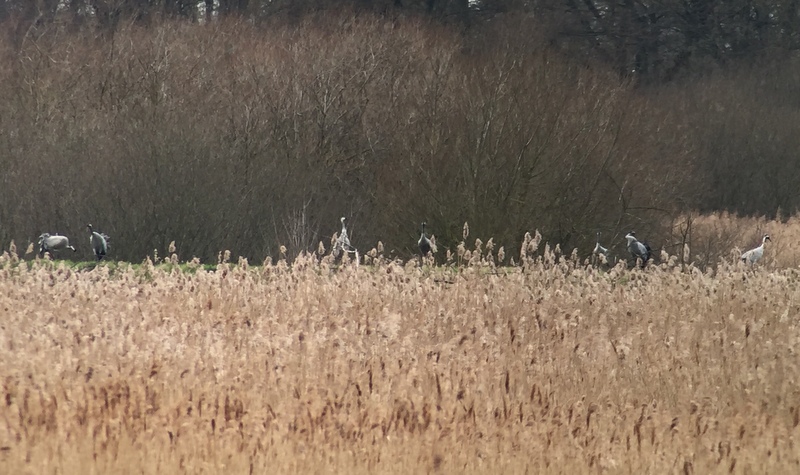 Common Crane – seven birds in a line, on the river bank
Common Crane – seven birds in a line, on the river bank
The juvenile Crane was still with what we believed were its parents at this stage, but they were clearly not happy with it. The next thing we knew they started to chase after it. The poor juvenile scrambled down along the bank and back up the other side of the other two pairs of adults, where it was out of reach. It was all action – it was like watching a Crane soap opera!
It was rather hard to keep track of them for a while. Different Cranes were bickering, two flew off down to the edge of the river beyond, but it seemed we were missing one of the adults and the juvenile. The next thing we knew, three Cranes took off again – one of the pairs and the juvenile. We wondered whether the juvenile was being chased at first, but by the end it was not clear whether it was just trying to follow its parents. The three flew round over the reserve, turned back to the river, and then came straight over and past us along the river. Stunning! They disappeared off east, beyond the poplars and were lost to view.
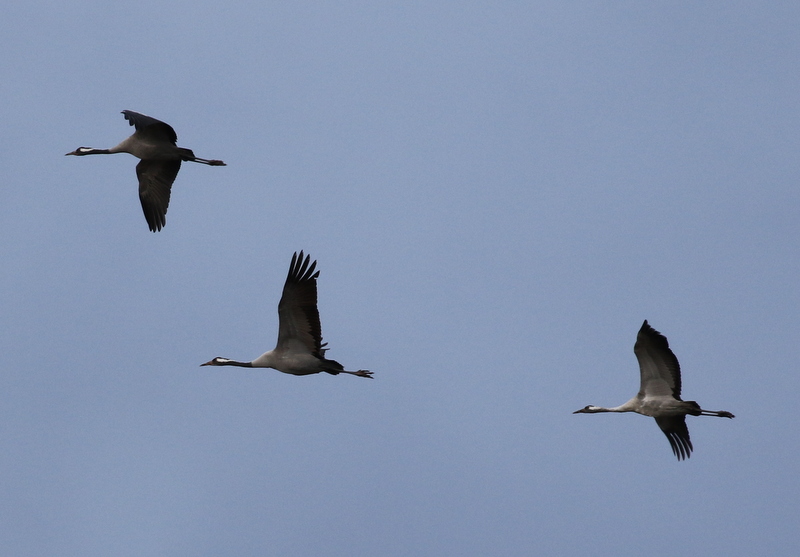 Common Cranes – two adults, followed by a juvenile
Common Cranes – two adults, followed by a juvenile
While we were watching the Cranes flying right past us, one of the group spotted a Great White Egret flying away along the river. All very confusing, we didn’t know where to look! After the Cranes had disappeared, we walked along the river to see if we could find it. A Little Egret flew off ahead of us and disappeared behind a bush. As we walked past, two egrets took off from behind it and we could see they were very different sizes. The Great White Egret dwarfed the Little Egret.
 Great White Egret and Little Egret – one big, one much smaller
Great White Egret and Little Egret – one big, one much smaller
The two egrets landed out of view in a channel in the wet meadows north of the river. But almost immediately, a male Marsh Harrier flew right over, flushing all the ducks and the egrets. We got a good look at the Great White Egret as it flew slowly away.
There were some more dark clouds approaching, so we made our way back to Joist Fen Viewpoint and sheltered as a brief shower passed over. Then we walked back across the reserve, with the dark clouds moving away ahead of us, the low sun lighting up the trees in front, and a double rainbow across the sky. Quite a view!
It had been a great way to end the day, and draw a very exciting weekend to a close, watching all the action with the Cranes. We made our way back to Mundord where part of the group left to head off south, while the rest of us continued on to North Norfolk.
POSTSCRIPT – as we drove through Swaffham, we could see an enormous flock of Starlings already starting to gather – we had thought we might be heading back too early to catch them, now the nights are drawing out. We couldn’t resist stopping.
The number of Starlings here still seems to be growing – there were at least 20,000 the last time we came but it looked to be much more than that now. The sky was black with birds. They were mostly flying round in a loose flock at first, a vast cloud covering the sky, rather than making tight shapes. But it was mesmerising standing underneath them, even if we were in danger of being spattered! The flock was composed of different layers, circling in different directions, it was enough to make you feel dizzy. We just stood and watched in awe.
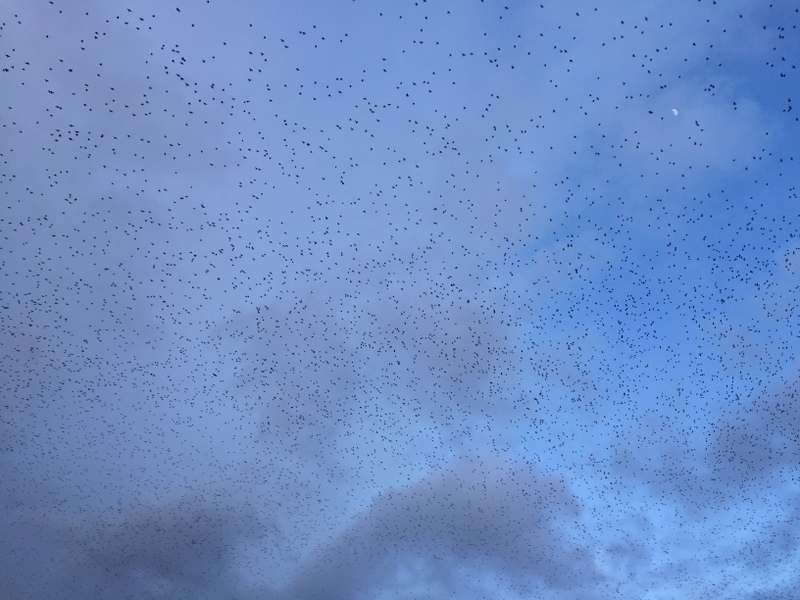 Starlings – a huge cloud over Swaffham
Starlings – a huge cloud over Swaffham
Gradually, as it started to get dark, the groups started to coalesce. The point before they actually go into roost is when the Starlings are at their most nervous. Now we started to see them making some shapes, swirling around. Finally, they started to drop into the trees. It was like someone had turned on a vacuum cleaner – the flocks circled lower and suddenly a stream of birds would drop like a stone and dive headlong into the bushes. It is amazing they don’t crash into each other.
The swirling flocks were remarkably quiet, apart from the hum from the beating of thousands wings, but once they get into the roost trees the Starlings start to chatter and their was a remarkable cacophony building as the sky emptied. Now it really was time to head for home.
